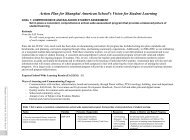Curriculum and Instruction - SAS-WASC
Curriculum and Instruction - SAS-WASC
Curriculum and Instruction - SAS-WASC
Create successful ePaper yourself
Turn your PDF publications into a flip-book with our unique Google optimized e-Paper software.
• Ensure a variety of types of assessment that reflect the st<strong>and</strong>ards assessed.• Investigate the nature <strong>and</strong> use of formative assessment as it applies tolanguage arts instruction at <strong>SAS</strong>• Organize professional development associated with Six Traits plus Onewriting assessment model with the goal that the model will be used writingevaluation tool across the curriculum.• Investigate various speaking rubrics that could provide common language forthis curricular str<strong>and</strong> (e.g., Oregon state speaking 4 traits: COLE)Mathematics 6-12 Program Review ReportWHAT CURRICULUM IS TAUGHTReview St<strong>and</strong>ards, Benchmarks <strong>and</strong> Unit PlansThe 6-12 mathematics task force reviewed st<strong>and</strong>ards <strong>and</strong> benchmarks. Algebra Ibenchmarks for grade 8 <strong>and</strong> grade 9 were aligned. The remaining st<strong>and</strong>ards <strong>and</strong>benchmarks were in order. The task force determined that not enough units wereposted at the beginning of the year to do an Atlas analysis of benchmarks covered,<strong>and</strong> tabled that analysis until 2008-2009.As with language arts, at the <strong>WASC</strong> midterm report very little was documented interms of mathematics written curriculum. This includes st<strong>and</strong>ards <strong>and</strong> benchmarks,scope <strong>and</strong> sequence, assessments, all of which are now either fully documented or inthe process of being documented on Atlas. The work is in progress <strong>and</strong> maintainingstrong links between what is posted <strong>and</strong> what is taught will be critical. The EAGLESare not fully integrated into units yet, nor are essential questions <strong>and</strong> reflections.Task force members agreed to share the Atlas data <strong>and</strong> progress with teams <strong>and</strong>departments.Principles of LearninThe task force drafted <strong>and</strong> adopted principles of learning to guide the work ofmathematics teaching <strong>and</strong> learning across the school.Mathematics Principles of Learning:• Mathematics is essential for success in a range of present <strong>and</strong> future careers• Mathematics equips students with thinking skills <strong>and</strong> problem-solvingstrategies that apply to authentic, real-life learning experiences, fosteringcuriosity <strong>and</strong> risk-taking, motivation, persistence <strong>and</strong> self-confidence.• Mathematics should provide all students challenge, equity <strong>and</strong> opportunity forsuccess.• Mathematics is a means of underst<strong>and</strong>ing the world through multicultural,historical, scientific <strong>and</strong> aesthetic perspectives.2. Essential Teaching Agreements were written <strong>and</strong> adopted for Mathematics 6 – 12school-wide. Agreements are intended to support best practice in the classroom:Mathematics teachers at <strong>SAS</strong> will ensure that students• Experience regular differentiated instruction according to individual learningneeds to enable each to reach his or her fullest potential.• Experience frequent authentic learning opportunities.• Have access to mathematics support outside of class.• Are continually encouraged to strive for excellence in mathematics throughboth processes <strong>and</strong> content.• Experience ongoing collaborative <strong>and</strong> reflective learning environments thatreinforce <strong>and</strong> apply previously-learned mathematics skills <strong>and</strong> knowledge.• Are assessed regularly through a variety of tools that help them constructmeaning.Shanghai American School Self Study Report 95



